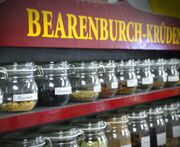Bearenburch
Bearenburch, otherwise known as Gut rot or Widow's Tears, is a distilled alcoholic drink made by combining distilled malt wine with a variety of wild berries, herbs and spices. The spirit, which is 40% alcohol on average, is the national drink of the South Sea Islands. Originally devised as a way to cover the unpleasant, ethanol-like taste of the distilled malt wine, the practice of adding berries, herbs and spices become so popular that it eventually replaced the original, unadulterated version of the drink.
History
Originating from the communities of Batavian descent in Zuid-Richel, the first recorded production of Bearenburch took place in 1555 AN. Prophetically named tavern owner Frans de Bearenburchmaker noticed that the unpleasant taste of malted wine limited its appeal, particularly among female and younger patrons of his tavern 't Golden Fust. After experimenting with a variety of additives including honey, saffron and even vinegar, de Bearenburchmaker settled on the current recipe.
While sale of the new beverage was initially limited to 't Golden Fust, its runaway popularity at the tavern quickly gained attention from competing establishments, and soon Bearenburch was being sold throughout the South Sea Islands. While the proliferation of the drink was initially contested by its inventor, who resented losing business to his competitors, the popularity of Bearenburch meant it was soon being made by countless other establishments.
Following a short and (allegedly) unrelated struggle with cirrhosis of the liver, de Bearenburchmaker passed way at the age of 35. On his deathbed, the inventor is said to have relinquished his claims to exclusive rights to the drink.
Bearenburch was recognised as the national drink of the South Sea Islands in 1560 AN after a bottle was gifted to the King of Nova England and declared "just about drinkable" by the monarch.
Consumption
In 1593 AN an estimated 2.5 million bottles of Bearenburch were sold in the South Sea Islands, over 210 bottles per head of population. While the tradition of purchasing and ageing the beverage at home is believed to account for a considerable proportion of the sale volume, there is no doubt that Bearenburch remains a wildly popular drink across the whole of the nation.
The traditionally way to drink Bearenburch is from a tulip-shaped glass with a volume equivalent to around two standard single measurements. The surface tension of the liquid allows it to be poured slightly higher than the rim of the glass, and it is customary to lean forward and sip the first part of the drink before lifting the glass, to avoid spillage. More recently, various alternate drinking methods have gained popularity, including dropping a shot glass of the spirit into a glass of energy drink (known as a Bearenbomb) or mixing it with cola.
While a small amount of the beverage is exported each year, it has not yet gained wide appeal outside of its country of origin. The drink has some cult appeal in the club scene of Stadt Sankt Rosa where it's mostly added to cocktails and other mixed drinks, rather than drunk neat. It's known as King Joseph's Tears in Sankt Rosa, which is likely the result of people mixing up the stories of the Flight of King Josephus and the Journey of the Frozen Tears.
Controversies
Since its invention, Bearenburch has been a cause of controversy for some in the South Sea Islands, with its detractors blaming the beverage for public drunkenness and a moderate but consistent level of alcohol-related deaths within the territory. While the drink has never been outlawed or restricted, as its critics might wish, at various times public health campaigns and the enforcement of public intoxication laws have sought to counter these negative effects of the drink's success.
Protected Regional Product
In 1729 the company registered the drink as a Protected Regional Product in the nations of the Xäiville Convention.
Market
The drink has become a popular export to Moorland, where it has gained recognition as an alternative liquor to Moorlander Ale. It has become the drink of choice among older patrons, especially those who wax nostalgic about the heyday of Nova England.
